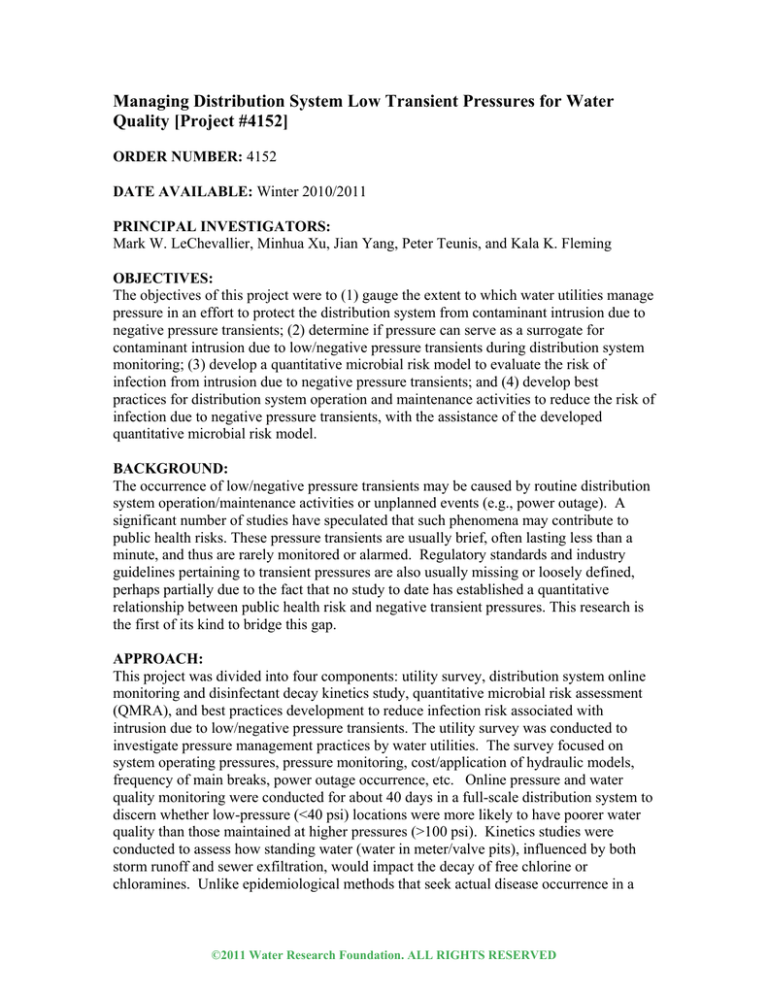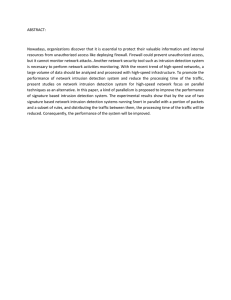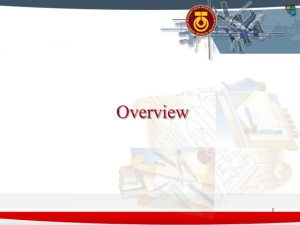
Managing Distribution System Low Transient Pressures for Water
Quality [Project #4152]
ORDER NUMBER: 4152
DATE AVAILABLE: Winter 2010/2011
PRINCIPAL INVESTIGATORS:
Mark W. LeChevallier, Minhua Xu, Jian Yang, Peter Teunis, and Kala K. Fleming
OBJECTIVES:
The objectives of this project were to (1) gauge the extent to which water utilities manage
pressure in an effort to protect the distribution system from contaminant intrusion due to
negative pressure transients; (2) determine if pressure can serve as a surrogate for
contaminant intrusion due to low/negative pressure transients during distribution system
monitoring; (3) develop a quantitative microbial risk model to evaluate the risk of
infection from intrusion due to negative pressure transients; and (4) develop best
practices for distribution system operation and maintenance activities to reduce the risk of
infection due to negative pressure transients, with the assistance of the developed
quantitative microbial risk model.
BACKGROUND:
The occurrence of low/negative pressure transients may be caused by routine distribution
system operation/maintenance activities or unplanned events (e.g., power outage). A
significant number of studies have speculated that such phenomena may contribute to
public health risks. These pressure transients are usually brief, often lasting less than a
minute, and thus are rarely monitored or alarmed. Regulatory standards and industry
guidelines pertaining to transient pressures are also usually missing or loosely defined,
perhaps partially due to the fact that no study to date has established a quantitative
relationship between public health risk and negative transient pressures. This research is
the first of its kind to bridge this gap.
APPROACH:
This project was divided into four components: utility survey, distribution system online
monitoring and disinfectant decay kinetics study, quantitative microbial risk assessment
(QMRA), and best practices development to reduce infection risk associated with
intrusion due to low/negative pressure transients. The utility survey was conducted to
investigate pressure management practices by water utilities. The survey focused on
system operating pressures, pressure monitoring, cost/application of hydraulic models,
frequency of main breaks, power outage occurrence, etc. Online pressure and water
quality monitoring were conducted for about 40 days in a full-scale distribution system to
discern whether low-pressure (<40 psi) locations were more likely to have poorer water
quality than those maintained at higher pressures (>100 psi). Kinetics studies were
conducted to assess how standing water (water in meter/valve pits), influenced by both
storm runoff and sewer exfiltration, would impact the decay of free chlorine or
chloramines. Unlike epidemiological methods that seek actual disease occurrence in a
©2011 Water Research Foundation. ALL RIGHTS RESERVED
population, QMRA estimates the risk of infection from known or inferred pathogen
levels at the point of water consumption. In this study, norovirus and rotavirus were
selected as the microbial pathogens for the quantitative microbial risk modeling.
RESULTS/CONCLUSIONS:
Utility Survey. Surveyed systems typically monitored pressures at convenient locations
(pump station, storage tanks, and pressure regulating valves) to determine distribution
system operating pressures. Pressure monitoring was less commonly conducted at
critical areas within distribution systems (e.g., high elevation areas and locations where
the utility did not already maintain a facility). Fifteen (32%) surveyed systems had
locations that were operated at pressures of <35 psi, and most of these locations (93%)
were attributed to high elevations. The average number of power outages within the
surveyed systems was 4.7 during the year, which was close to the reported average of 5
per year. Utility perception on the prevalence of their systems’ vulnerability to
backflow/negative pressure events was also surveyed. About 65% and 30% of
respondents estimated that at least one water hammer event and at least one negative
pressure event, respectively, had occurred in their systems during the year before the
survey. Given the lack of pressure monitoring targeted to capture transient pressures,
these responses appeared to be optimistic and the actual occurrence levels might be
higher considering most transient events last less than a minute and would go undetected.
Distribution System Online Monitoring. No significant relationship was found between
variations in pressure and free chlorine residuals at any of the monitoring locations. This
result was not unexpected, because observable water quality deterioration (i.e., loss of
chlorine residual) at a location may require a combination of intrusion of large volumes,
standing water with a high total organic carbon (TOC) level, and an open portal for
intrusion at the location (e.g., a leak). Unless low pressures were associated with highstrength and prolonged intrusion (e.g., cross-connection to pressurized sewer mains), it is
unlikely that pressure can be used as a general monitoring parameter for water quality
deteriorations.
Impact of Intruded Water on Disinfectant Decay Kinetics. Results showed that intruded
water with high TOC levels exerted a high chlorine demand. Intrusion of volumes up to
1% of studied water (generally with TOC levels less than 10 mg/L) had no significant
impact on free chlorine/chloramine decay kinetics. Similarly, intrusion of 0.1%
wastewater had little impact on chloramine decay kinetics. This suggests that in the
absence of a prolonged intrusion event, online monitors would have difficulty identifying
intrusion in small volumes, especially if the TOC levels of the intrusion are low (under 10
mg/L).
Quantitative Microbial Risk Modeling. Under the baseline scenario, intrusion of
norovirus and rotavirus associated with a negative pressure transient event was estimated
to cause a median infection risk of 2.1 x 10-4 and 1.1 x 10-4, respectively. These risk
levels were slightly higher than the USEPA acceptable level of annual infection risk (104
), assuming one negative pressure transient event per year in the system. If the system
had 5 power outages per year and each power outage caused a similar negative pressure
©2011 Water Research Foundation. ALL RIGHTS RESERVED
transient event, the annual risk of norovirus infection would be 1.1 x 10-3, about one order
of magnitude higher than the USEPA acceptable risk level of 10-4.
Infection risks had a heterogeneous spatial pattern due to the geographic locations of
intrusion, hydraulic mixing/dilution, virus transport, and hydraulic washout. Within 24
hours of a simulated intrusion, about 50% of customers in the east of the system were
estimated to have no risk of infection, while some customers in the west of the system
had infection risks as high as 10-3. The sensitivity of the infection risk to risk driving
factors was evaluated by fixing a factor at the respective average value while allowing the
other factors to vary throughout their respective ranges. The strongest influence on the
variation of the infection risk was from the coincidence factor, which represents the
probability that a customer will drink water from the contaminated slug. The second
most important factor was the duration of the negative pressure event, which was directly
linked to the coincidence factor.
APPLICATIONS/RECOMMENDATIONS:
Optimizing Pressure Management. The risk results under the mitigation scenarios
showed that both reducing the number of locations experiencing negative pressures and
the duration of negative pressure events could significantly reduce the risk of infection.
Therefore, focusing efforts on improved pressure management can have positive impacts
on the public health quality of drinking water. Optimized pressure management targeted
to control negative pressure transients was the most effective risk mitigation measure.
Short periods (seconds) of low/negative transient pressures below 20 psi often go
undetected for a variety of reasons. In closed systems with no elevated storage, start up
of stand-by power may be too slow to prevent pressure transients. To account for both
normal and transitory pressures in distribution systems, the optimization of a pressure
management program requires a combination of hydraulic modeling, surge modeling,
pressure monitoring, and transient pressure mitigations. The optimized pressure
management program will yield utility-specific best practices such as building floating
storages, adding hydropneumatic tanks, upsizing water mains, etc. Two case studies are
presented to illustrate optimized pressure management practices. The microbial risk
model can be used to compare the risks of negative pressure events in systems with and
without best pressure management practices (e.g., with and without a
floating/hydropneumatic storage).
A utility may start a pressure management program by reviewing the existing system
using a hydraulic model. The cost to develop and maintain a hydraulic model can be
justified by its wide range of applications (See Chapter 3: Hydraulic Model Cost). Surge
models can be used to improve the understanding of how a system may respond to a
variety of events that can create rapid changes of flow conditions. Key elements include
(1) causes of transient events; (2) the magnitude and duration, as well as locations of
lowest pressures; and (3) monitoring plan for transient pressures. Although this study
focused on risk associated with negative pressure transients, pressure monitoring could be
targeted to manage both low and high transient pressures, as well as pressures under
normal conditions. A general framework of the pressure monitoring/management
program is provided. The strategies to control transient pressures may be classified as
©2011 Water Research Foundation. ALL RIGHTS RESERVED
either direct action or diversionary tactics. References are provided for the information
on the functionality of these surge protection devices, together with a rationale of
choosing appropriate surge protection strategies (direct, diversionary, or both).
Maintaining Adequate Disinfectant Residuals. The risk results under the mitigation
scenarios showed that maintaining a free chlorine residual of 0.2 mg/L or higher reduced
the risk of infection to insignificant levels. Chloramine residuals did not appear to have a
significant impact on reducing the risk. For utilities that use chloramines as disinfectant
residual, other preventive measures (e.g., pressure management and surge protection)
should be emphasized to a greater extent to reduce the public health risks due to negative
pressure transients. A program for maintenance of adequate disinfection residuals in
distribution systems should be implemented as required by federal, state, or local
regulations. If the regulatory standards do not exist, the program could be implemented
according to the AWWA or Ten State Standards (2007). These standards recommend
that a disinfectant residual of at least 0.2 mg/L free chlorine or 0.5–1.0 mg/L chloramines
should be maintained in distribution systems.
Other Practices. Ensuring adequate separation distance from sewer mains, leak detection
and repair, and cross connection control may reduce pathogen levels and chlorine
demand of the contaminant intrusion into the drinking water pipes. If a disinfectant
residual is maintained, these practices may reduce chlorine demand of the intruded water
and an adequate free chlorine residual is effective to reduce the risk of viral infection. It
should be noted that the goal of leak detection for water loss control and for reducing the
risk of viral infection from intrusion may have different emphasis. This difference may
have a significant impact on the selection and employment of leak detection techniques.
A cross connection control program should be prioritized in areas vulnerable to negative
pressure transients to reduce the overall risk of infection. Emergency response planning
should include protocols to decontaminate distribution system mains that are subject to
negative pressure events. A utility may consider boosting disinfectant residual in the
system, issuing a boil water notice, or flushing to remove intruded contaminants.
Flushing is the simplest and most effective approach to remove contaminants if
administered in time.
RESEARCH PARTNER:
American Water Works Service Company, Inc.
©2011 Water Research Foundation. ALL RIGHTS RESERVED





